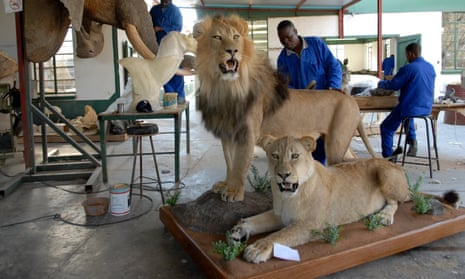Lion numbers are in steep decline across Africa, but trophy hunting is only partly responsible for the long-term losses, say conservationists.
According to UK-based charity Lion Aid, trophy hunters in Zimbabwe killed around 800 lions in the 10 years to 2009, out of a population in the country of up to 1,680.
This compares with a total of 990lions killed for sport in Botswana, Zambia, Namibia and Mozambique combined over the same period.
South Africa, where hunters legally kill around 260 a year, is the world centre of lion hunting but nearly all those killed for sport are bred in captivity, in a practice known as canned hunting. In central and west Africa there is less hunting because lion populations are nearly all in steep decline or extinct.
“Lions are grossly over-hunted in Zimbabwe concessions, lured out of national parks and there is corruption. Quotas are exceeded. It is highly unsustainable,” said a spokesman for Lion Aid, following the illegal killing of a 12-year-old lion known as Cecil who was lured out of Hwange national park by an American hunter.
But many conservationists say that without trophy hunting there would be no lions at all.
“The land would be used for farming and this would accelerate the loss of wildlife. We don’t like trophy hunting but it slows the rapid decline of populations. It is a necessary evil,” said Guy Balme, director of the leopard programme in Africa for US-based conservation group Panthera.
Governments encourage hunting because most of the land used for hunting is not suitable for tourism. “The problem is we don’t have the alternatives to hunting. In many areas where lion hunting takes place there is no other wildlife-based industry. I don’t condone it. The shooting industry uses the excuse that hunting is better than the alternatives, but it can only be a short-term solution,” said Balme.
Data on lion numbers is not reliable, said Peter Lindsey, a lion conservation specialist at Zimbabwe university and author of a survey of trophy hunting in Africa. He has argued in academic papers that hunting could be a positive force because it provides an economic motive for maintaining wildlife habitats.
“But in countries like Tanzania, which holds 30-50% of all Africa’s wild lions, trophy hunting appears to be the primary driver of lion population declines outside protected areas,” said Lindsey.
The hunting industry is believed to contribute over $200m (£130m) a year to African governments, through permits, taxes and quotas. The money is in theory used to support national parks and wildlife conservation.
South African organisation Hunting Legends this week quoted $35,000 to kill a male lion in his prime, $13,000 for a buffalo, $8,500 for a crocodile and $60,000 for a large elephant. A Vervet monkey can be shot for $170, said its website.
According to a 2007 paper by Lindsey, lions generate up to 17% of Africa’s hunting income and attract the highest prices from hunters. “[But] Trophy hunting also lowered the population density of lions and affected the behaviour of lions in Hwange national park [where Cecil the lion lived] in Zimbabwe,” he said.
The theory is that when hunting is well managed, the jobs and money generated give local people an incentive to suppress poaching and keep animals alive. “Unfortunately the benefits do not always go to people on the ground,” said Balme.
According to Lindsey, sports hunters are some of the biggest tourist spenders, paying much more per head than wildlife tourists. In 2006, 18,500 hunters paid over $200m to hunt lions, leopards, elephants, buffalo and impala in Africa.
In addition, said Lindsey in the same 2007 paper, private hunting operations protect large areas of poor farmland that is not suitable for wildlife watching. The 23 countries that allow trophy hunting in Africa together control more than 540,000 sq miles (1.4m sq km) of land, over 20% more than is protected by national parks.
More serious for lion conservation than trophy hunting, say conservationists, is habitat fragmentation, conflict with pastoralists over livestock, and the loss of range land.

Comments (…)
Sign in or create your Guardian account to join the discussion